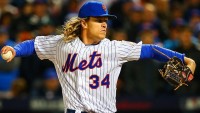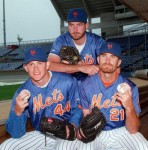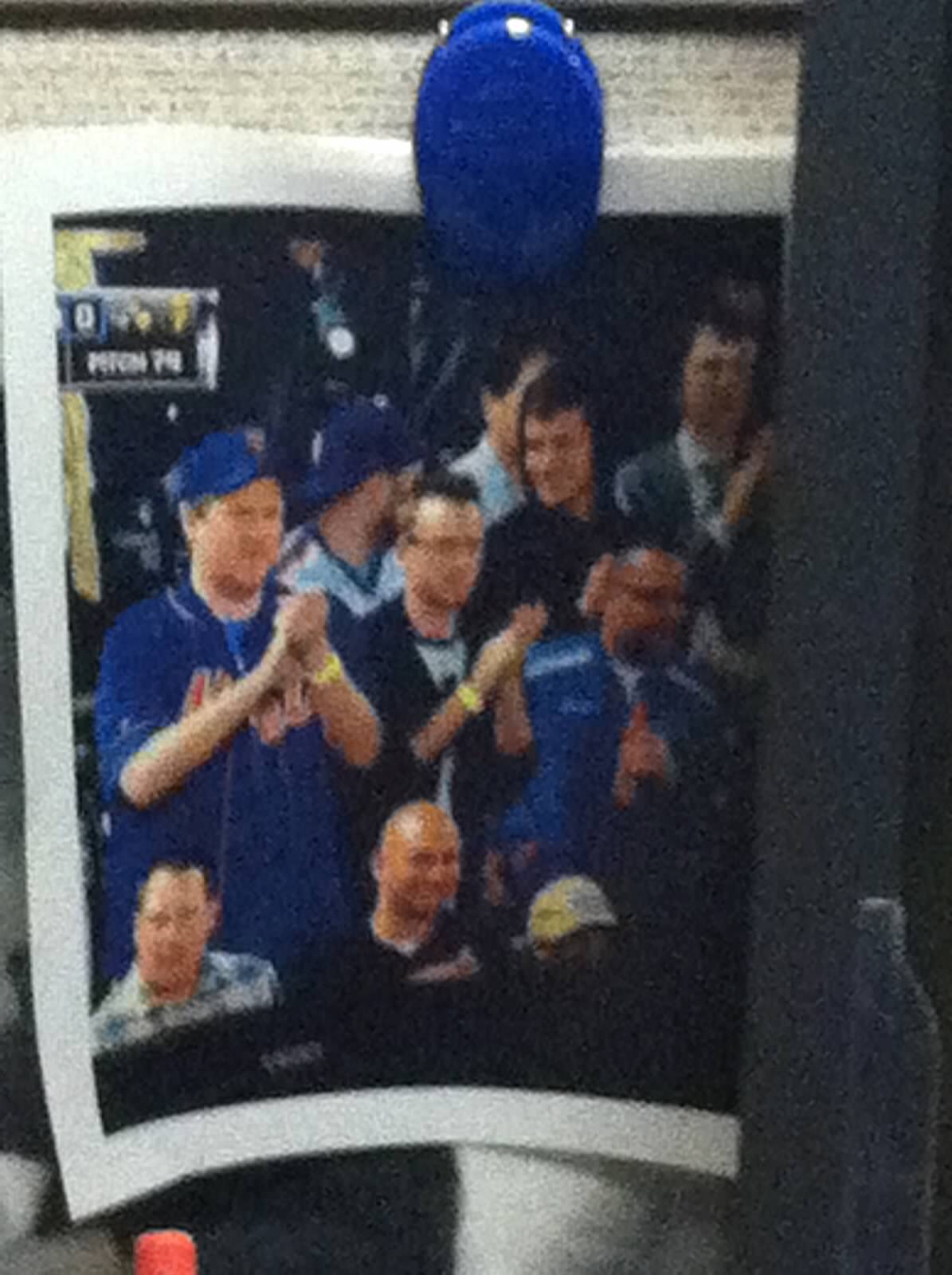Bill Pulsipher
Want to know how things went for the Mets today? Their best pitcher was Kevin Plawecki who allowed four runs on three homers in two . . . TWO! . . . innings pitched.
How the Mets got there is almost too exhausting to detail. Suffice it to say, it all started with Noah Syndergaard. After refusing an MRI for biceps complaints, the Mets sent him to the mound on Sunday. To be fair, Syndergaard probably thought MRI meant Mets related injury.
Every Mets fan knew what would happen. We knew he’s get injured. We’ve been expecting it since Generation K went up in flames with the injuries suffered by Jason Isringhausen, Bill Pulsipher, and Paul Wilson. And it happened. After 1.1 innings where he allowed five hits, five runs, two walks (first two of the season) while striking out two, he was gone with a “lat injury.” It’s in quotes because it’s clear no one knows what’s going on with Syndergaard.
From there, it’s difficult to decipher what happened.
Even with the Syndergaard injury, the Mets were only down 6-5 heading into the bottom of the fourth.
Everyone was pitching in (pun intended). The resurgent Jose Reyes, moved to second in the lineup due to players getting the day off, got it all started with a first inning one out triple. Jay Bruce was 3-4 with a homer and two RBI. Rene Rivera had a homer of his own. Even Sean Gilmartin got in on the action with an RBI double.
Gilmartin, that’s where the trouble started. Initially, he kept the Nationals at bay when he came on after the Syndergaard injury. But, he melted down in the fourth allowing four earned. Gilmartin, like the rest of the Mets was victimized by Anthony Rendon, who hit two homers off of him.
Fernando Salas started the fifth, and he eventually put the game completely out of reach allowing three runs. When he left, it was 13-5. The Nationals still had 10 runs left in them.
Six of them came off Josh Smoker, who melted down in his second inning of work. He didn’t record one out while facing five batters that inning. He and the whole team left Terry Collins little choice. He had to go to a position player to pitch the final two innings.
It was hard to tell if Plawecki was throwing a knuckleball or a batting practice fastball. The answer was a knuckleball, but the Nationals were teeing off of him and all Mets pitchers like it was batting practice. Whether it was the knuckleball or the fact that Plawecki was the least important player on the roster, it was an inspired choice by Collins.
What wasn’t inspired was how the Mets finished this series. After rallying back from losing six in a row, 10 of 11, and Yoenis Cespedes, the Mets beat Max Scherzer and Stephen Strasburg in back-to-back games. It was an announcement the Mets weren’t done. It was enough to give a Nationals team, who just lost Adam Eaton for the season, doubt they were the better team.
Twenty-three runs later, in a game started by Syndergaard, that doubt should be erased. Trea Turner was the only Nationals starter without a multi-hit game, and he still hit a double and scored a run.
More than that, Rendon was 6-6 with five runs, a double, three homers, and 10 RBI. The Mets as a team had five runs on nine hits.
Game Recap: Reyes had another error, but this one was at shortstop as the Mets gave Asdrubal Cabrera the day off. Neil Walker had another poor game at the plate and is now hitting .195. Same goes for Curtis Granderson who is now hitting .128.

Going into the 2016 season, there is one fear each and every Mets fan has. We dare not speak its name, but that doesn’t change the fact that it’s still present. That fear is that a pitcher will get seriously injured.
Looking at this year’s list of pitchers who could befall the dreaded “Verducci Effect,” Noah Syndergaard headlines that list. If Syndergaard was to suffer a season ending injury requiring Tommy John surgery? it would greatly hinder the Mets chances of winning not only the World Series, but also making it to the postseason. It’s something that not just Mets fans fear, but as Anthony DiComo of MLB.com reports, Syndergaard fears it also:
I’ve thought about it quite a bit. But I trust myself to put my body in the right situations to be able to perform at a healthy level.
The fear is justified. Syndergaard threw 65.2 innings more last year. He throws over 95 MPH more than anyone in the game. He’s working to add the fabled Warthen Slider to his already dominant repertoire. Name a risk factor for UCL years requiring Tommy John surgery. Syndergaard meets most if not all of them.
One risk factor not readily discussed is the team he plays for. Look at the projected Mets rotation when healthy: Matt Harvey, Jacob deGrom, Noah Syndergaard, Steven Matz, and Zack Wheeler. Put aside Syndergaard for a moment. What do the other four have in common? They are all hard throwing pitchers under the age of 30 who have already had Tommy John surgery.
Go outside this group. Since Warthen took over as the Mets pitching coach, the following homegrown Mets have sustained arm injuries: Jon Niese (shoulder), Dillon Gee (shoulder), Jeremy Hefner (two Tommy John surgeries), Rafael Montero (shoulder), Bobby Parnell (Tommy John), Josh Edgin (Tommy John), Jack Leathersich (Tommy John). There are more, but you get the point.
Now, is this an organizational problem since Warthen took over, or is it just bad luck? Could this all have been avoided? Back in the 60’s and 70’s the Mets developed pitchers like Tom Seaver, Jerry Koosman, Nolan Ryan, and Jon Matlack. These pitchers threw more innings than the pitchers today, and yet, Matlack was the only one of this group that suffered an arm injury.
In the 80’s, the Mets had Dwight Gooden, Ron Darling, Sid Fernandez, Rick Aguilera, Randy Myers and David Cone. Of this group, only Doc and Cone had arm issues. It should be noted that Doc had many other issues as well, and Cone’s problem was an aneurysm later in his career.
In the 90’s, Generation K was a bust, and the Mets haven’t developed the caliber of starting pitchers like they have in the past until now. However, this generation seems to befall injuries far more often than their predecessors. Is it organizational? Is it bad luck? Is it preparation? For his part, Harvey wonders what if:
I think now, there are things I could have done better in high school or in college to maybe prevent it. But I don’t know. I’m not saying [Syndergaard] works that much harder than everybody else, because we all work hard. I think as time progresses, guys pay more attention to stretching the shoulder, strengthening the shoulder. If I could go back — I don’t know if this would’ve prevented me from having [surgery], but if I could go back and really do 20 extra minutes of stretching and arm care, you never know what could happen.
That’s the thing. We really don’t know why one guy suffers elbow and shoulder injuries while others don’t. Is it preparation? Is it good genes? Is it just good luck? Much time, energy, and money has been spent on this issue, and yet pitchers still get injured. Pitchers get injured despite teams doing everything in their power to try to prevent it.
It will help Syndergaard being in a clubhouse with players who have had Tommy John surgery. They each will have advice for him on why they suffered the injury and what they could’ve done differently. More importantly, Syndergaard appears to be a hard worker who takes the health of his arm very seriously. There is no doubt he is doing everything he can do to avoid the dreaded Tommy John surgery.
Based on what we’ve seen, if anyone can avoid it, it’s him.
Editor’s Note: this article was first published on metsmerizedonline.com

The year was 1996. The Mets were supposed to open the season with a trio of pitchers dubbed Generation K. Jason Isringhausen, Paul Wilson, and Bill Pulsipher were all supposed to usher in the next era of great Mets pitching. They were supposed to win multiple Cy Youngs and World Series titles.
It never happened.
Bill Pulsipher
Pulsipher was the first to arrive on the scene. In his first year in AA, a 20 year old Pulsipher pitched 201.0 innings. The prior year he only pitched 139.2 innings. The following year, 1995, Pulsipher would pitch in AAA and get called up to the majors. He threw 218.1 innings. Pulsipher wouldn’t pitch in 1996 as he had a torn ligament in his pitching elbow.
In Pulsipher’s rookie year, he made 17 starts. He never reached that plateau again. His last major league appearance came in 2005 when he was 31 years old. When Pulsipher made those five appearances, it was the first time he pitched in the big leagues since 2001. Pulsipher finished his career going 13-19 with a 5.15 ERA in 46 starts and 60 relief appearances.
Paul Wilson
Unlike Pulsipher, Wilson burst on the scene in 1996. He was the first overall pick in the 1994 draft after dominating at Florida State. In 1995, Wilson pitched his first season of professional ball, and he pitched well in his 186.2 innings. So well in fact, that the Mets called him up to the majors. He went 5-12 with a 5.38 ERA in 26 starts. His season would end as he needed arthroscopic surgery to repair a torn labrum in his pitching shoulder.
Wilson would never pitch for the Mets again. He would be part of a trade on 2000 for a fourth outfielder in Bubba Trammel and a bullpen arm in Rick White. He finished his career going 40-58 with a 4.86 ERA in 153 starts and 17 relief appearances.
Jason Isringhausen
Without a doubt, Isringhausen had the best career of the Generation K pitchers, and he had to go to the bullpen to do it.
Isringhausen burst on the scene in 1995. In 14 starts with the Mets, he went 9-2 with a 2.81 ERA. Even though he only pitched in half a season, he was so impressive that he finished fourth in the Rookie of the Year voting. While he may not have been the most heralded pitcher of Generation K, he had the most success out of all of them when he was first called up. However, that success would not last as like the other two pitchers, Isringhausen’s arm was a ticking timebomb.
In 1994, the year before Isringhausen pitched in the majors, he threw 193.1 innings. The year before? He threw only 90.1 innings. In his career, Isringhausen would need shoulder surgery and three Tommy John surgeries. This doesn’t even include surgery for a broken wrist because he lost a fight with a water cooler.
Isringhausen would eventually make two All Star teams due to his work as a closer. He would record 300 saves. The last seven were with the Mets in 2011 when he came back on a minor league deal. At that point, he served as a mentor to a young bullpen. It was a nice bookend towards the end of his career. The former young hothead with arm troubles became a veteran leader.
Generation K
These three heralded young pitchers were ruined by the Mets organization. They were needlessly pushed beyond their limits in the minors and majors. As a result, they had a series of shoulder and elbow injuries. The heralded trio would never appear in the same rotation.
Epilogue
It’s been four years since Isringhausen has retired, and now people want to interview him when we talk about how prospects should be handled. Here’s what he revealed about how those Mets handled prospects:
Jason Isringhausen: In the minors if we didn't pitch 9 innings, we got a talking to. We didn't watch pitch counts as much as we do today
— MLB Network Radio on SiriusXM (@MLBNetworkRadio) March 3, 2016
Twenty years later, the Mets have a new trio, who for some reason don’t have a great nickname like Generation K. While Jacob deGrom and Matt Harvey have had Tommy John surgery, the Mets handle their young aces much better now. They took better care of their pitchers during the rehabilitation process. Last year, we saw deGrom and Harvey team up with Noah Syndergaard to pitch the Mets into the World Series.
This was supposed to happen 20 years ago. It’s happening now. So next time, the Mets are too patient with a player, or a player or his agent voice concerns over a pitcher’s workload, remember Mets fans were robbed of seeing three aces in one staff due to over usage of the young pitchers.
I’m sure innings limits, six man rotations, and skipped starts will be a story line at some point in 2016. When it does, embrace it because the Mets not using that forward thinking might’ve cost at least one World Series title. Young pitchers are fragile, and they need to he handled as such. If you don’t, the workload could lead to injuries and/or ruined careers. Next thing you know, the window to win a World Series is slammed shut.
I’m not willing to see another chance go by the wayside due to some meaningless starts again.
I know where I was three years ago. I was sitting in front of the TV in my basement watching Matt Harvey make his major league debut against the Arizona Diamondbacks. It was important to watch that game because it was the first glimmer of hope Mets fans since the collapses closing out Shea.
It’s been a whirlwind since then. He started by striking out Gerardo Parra (yes, that Gerardo Parra) in a record setting 11 K, 5.1 inning shutout win. He would finish 3-5 with a 2.73 ERA in 10 starts. He showed us glimpses of his potential.
In 2013, he started out like gangbusters. From the outset, he was the NL Player of the Week and April’s Player of the Month. He was in ESPN’s “The Body” issue. He almost had a perfect game (my second SNY appearance):

He had the epic Jimmy Fallon appearance. He then became the youngest All Star Game starter since Dwight Gooden. The fact he did it at Citi Field was all the more special.
Then things started to turn sour. The Mets let him pitch through forearm tightness (paging Dr. Warthen). After he was shut down, he fought seemingly everyone on getting the surgery (because the Mets should control anyone’s medical decisions). Now all of a sudden his Rangers fandom was a problem (because hanging around and learning from Lundqvist is a bad thing). He had the gaul to want to be around his teammates during his rehab. He had the audacity to seek to pitch one inning in 2014.
There were other missteps, some true and some overblown. Overblown: him paying respects to Derek Jeter. He wasn’t allowed to travel with the team. He goes and watches Derek Jeter’s home game (as inconspicuously as he could), and he gets blasted. By the way, we want our players to love and respect the game, and when Harvey does it, he’s vilified. The real ones were the social media gaffes.
Finally, 2015 mercifully arrived. He has been a very good starting pitcher, but not quite Matt Harvey yet. For his part, Harvey thinks he’s back. Let’s hope he is because I can’t stand the inane backlash from his travel arrangements to his being curteous after playing a round of golf. I can’t stand it.
You know what I see when I see Matt Harvey? I see a fierce competitor. I see a good teammate. I see someone who has handled fame and pressure well. He’s always at his locker answering questions, win or lose. I see a player whose nightlife activities include Ranger games. You don’t hear about all night drinking or drugs with him. After the 80’s, we should appreciate that.
On top of the lessons of the ’80’s Mets, we should remember the lessons of Generation K. The Mets were supposed to have three aces in Isringhausen, Pulsipher, and Wilson. That blew up rather quickly. We need to revere these pitchers while we have them (and while they are healthy).
For those of you who have read this blog before, my favorite player was Darryl Strawberry. My brother’s favorite player was Dwight Gooden. Trust me, that lead to some awkward conversations down the road with my Dad; conversations I frankly don’t want to ever have.
I hope my son grows to root for Harvey because: 1) he has so many positive traits to celebrate (competitiveness, accountability, he’s not a quitter); and 2) it means he will be effective with the Mets for a long time. I’m celebrating this day because it’s the anniversary of when the Mets started turning things around. I hope you are as well.